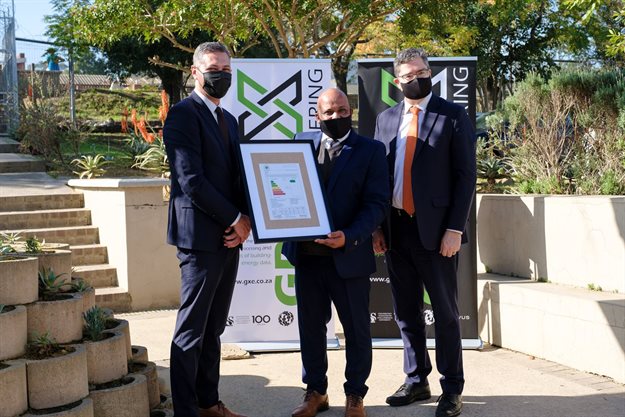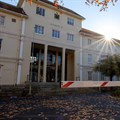Cloetesville Primary School in Stellenbosch has become SA's first school to receive an Electrical Performance Certificate (EPC). With the help of Stellenbosch University's (SU) spinout company GreenX Engineering, the school received an A rating for electrical consumption of 17kWh per square metre.

Cloetesville Primary receives its Electrical Performance Certificate. Image: Stefan Els
The EPC is the culmination of hard work and dedication, a great team effort and leaping over the final hurdle in completing his PhD, says managing director of GreenX, Jason Samuels.
Under the supervision of Thinus Booysen, professor in electrical and electronic engineering, and Saartjie Grobbelaar, associate professor in industrial engineering, Samuels is doing his PhD focusing on schools and their energy usage; creating methods to reduce their consumption and systems to manage the school more efficiently. Samuels, Booysen and Grobbelaar, together with entrepreneur Mario Roos, established GreenX Engineering with the help of Innovus Technology Transfer, SU’s innovation division. Booysen and Grobbelaar are both non-executive directors of GreenX Engineering.
“GreenX Engineering’s creation can be traced back two years ago when I heard Prof Booysen on the radio talking about his involvement in projects to help schools in and around Stellenbosch and Paarl save water and electricity. I realised that my specialised lighting and electrical maintenance company could become an essential partner to Booysens initiatives at schools,” said Roos, and the conversation started.
Roos said that when the amendment to the National Energy Act of 1998 was proclaimed in December 2020 by the minister of mineral resources and energy – requiring building owners to publish the electrical consumption per square metre by 2022, they saw a gap in the market for establishing a company that can ensure that buildings adhere to this new regulation.
Helping schools reduce their energy bills
As GreenX’s technical director, Booysen brings to the company his technical expertise and experience with assisting schools to become more energy efficient and reduce their electricity and water bills. “There are many schools with no financial or technical means to manage their energy and water resources efficiently. We initially started with 13 schools, and this number has grown to 25 schools in the Stellenbosch and Paarl area. Thanks to funding from the Western Cape Education Department, as well as from SU’s social impact and transformation department, we can equip these schools with energy-saving technology to help them reduce their energy bills,” says Booysen.
For Roos, the dream is to ensure energy efficiency at all South African schools and actively reduce their carbon footprint. “Our calculations show that we can take out 120kg of carbon emissions per school per day. So, if we could expand our programme to incorporate all 1,600 schools in the Western Cape, it will translate to taking out 90 million kg of carbon emissions per year.”
Roos believes they are creating a blueprint that could be duplicated across the country and internationally. “Our initial focus is schools, whereafter we will roll out to corporate and government buildings across the country.”
For Grobbelaar, the business model they have created will allow the company to grow while retaining a solid link to SU’s engineering research expertise. “Initiatives such as these is bringing SU’s research into the real world and actively changes the lives of people – currently starting at school level; a place where all people need to move through at some point in their lives.”
















































